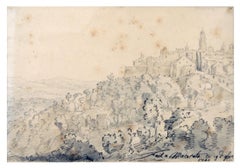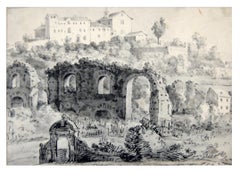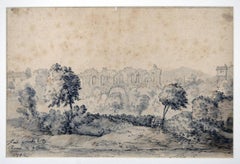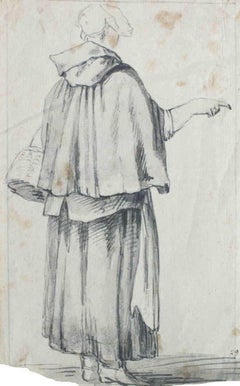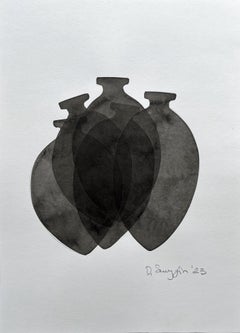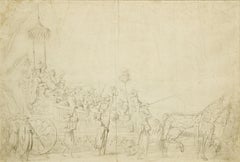Jan Peeter Verdussen Figurative Drawings and Watercolors
to
12
15
3
7
8
3
Overall Height
to
Overall Width
to
7
6
6
5
4
3
2
2
1
1
1
1
1
1
1
1
1
1
1
1
17
1
17
20
672
326
198
132
11
11
9
9
Artist: Jan Peeter Verdussen
Ruines Romanes - Roman Ruins - Ink and Watercolor by J. P. Verdussen - 1742
By Jan Peeter Verdussen
Located in Roma, IT
China ink and watercolor on paper.
Hand dated.
Conditions: Foxing on the top right of the paper
Category
1740s Old Masters Jan Peeter Verdussen Figurative Drawings and Watercolors
Materials
Watercolor, Ink
Vue de Macerata et de sa Campagne - drawing by J. P. Verdussen - 1742
By Jan Peeter Verdussen
Located in Roma, IT
China ink and watercolour on paper.
Some foxing, otherwise very good condition.
Titled and dated.
Includes passepartout.
Category
1740s Jan Peeter Verdussen Figurative Drawings and Watercolors
Materials
Watercolor, Ink
La Campagne de Rome - Roman Countryside - Drawing by J. P. Verdussen - 1740ca
By Jan Peeter Verdussen
Located in Roma, IT
China ink and watercolour on paper.
Realized in 1740 ca.
Very good conditions.
Includes passepartout.
Category
1740s Old Masters Jan Peeter Verdussen Figurative Drawings and Watercolors
Materials
Watercolor, Ink
The Gardens of Rome - Ink and Watercolor by J. P. Verdussen - 1742
By Jan Peeter Verdussen
Located in Roma, IT
China ink and watercolor on paper realized by Jan Peter Verdussen in 1742.
Hand dated.
Conditions: five holes on top margin and on the bottom right of the paper. Foxing on the top ...
Category
1740s Jan Peeter Verdussen Figurative Drawings and Watercolors
Materials
Watercolor, Ink
La Bataille - The Battle - Drawing by J. P. Verdussen - 1740s
By Jan Peeter Verdussen
Located in Roma, IT
China ink and watercolor on paper.
Conditions: Two cuts on the centre of the paper. Three holes on centre-right, botton-left and top-left of the paper.
Worn on the top left of the ...
Category
1740s Old Masters Jan Peeter Verdussen Figurative Drawings and Watercolors
Materials
Watercolor, Ink
Girl - Ink and Watercolor by J. P. Verdussen - 18th Century
By Jan Peeter Verdussen
Located in Roma, IT
Girl is a china ink drawing realized b Jan Peter Verdussen in the mid-18th Century.
Good condition except for some missing parts in the lower left and right edges.
Category
Mid-18th Century Jan Peeter Verdussen Figurative Drawings and Watercolors
Materials
Ink
The Gardens in Rome - Drawing by J. P. Verdussen - 1741
By Jan Peeter Verdussen
Located in Roma, IT
China ink and watercolour on paper.
Hand dated.
Good condition except for some foxing.
Category
1740s Jan Peeter Verdussen Figurative Drawings and Watercolors
Materials
Watercolor, Ink
Landscape - Drawing by Jan Peter Verdussen - 1745 ca
By Jan Peeter Verdussen
Located in Roma, IT
Landscape is a beautiful drawing in pencil and watercolor on paper realized by Jan Peter Verdussen in 1745 ca.
In good condition, excpet for some foxing on the right.
The artwork r...
Category
1740s Old Masters Jan Peeter Verdussen Figurative Drawings and Watercolors
Materials
Watercolor, Pencil
Rome/Tevere - Pencil and Watercolor Drawing - 1781
By Jan Peeter Verdussen
Located in Roma, IT
Rome is a beautiful artwork realized by Jan Peter Verdussen in 1741.
In good condition except for some pencil marks and traces of sealing wax on the back and some diffused foxings.
...
Category
1780s Old Masters Jan Peeter Verdussen Figurative Drawings and Watercolors
Materials
Watercolor, Pencil
Landscape - Watercolor and Pencil by Jan Peter Verdussen - 18th Century
By Jan Peeter Verdussen
Located in Roma, IT
Landscape is a beautiful dranwing in watercolor and pencil on ivory-colored paper realized by Jan Peter Verdussen.
In good condition; only a sma...
Category
18th Century Old Masters Jan Peeter Verdussen Figurative Drawings and Watercolors
Materials
Watercolor, Pencil
St. Gregory in Rome - Original Ink and Watercolor by J. P. Verdussen - 1741
By Jan Peeter Verdussen
Located in Roma, IT
St. Gregory in Rome is a beautiful artwork realized by Jan Peter Verdussen in 1741.
Ink and watercolour on brown paper. In very good codition. Dated on the lower margin. The origin...
Category
1740s Modern Jan Peeter Verdussen Figurative Drawings and Watercolors
Materials
Ink, Watercolor
Landscape - Pencil on Paper by J. P. Verdussen - 18th Century
By Jan Peeter Verdussen
Located in Roma, IT
Landscape is an original drawing is realized by Jan Peter Verdussen.
The artwork has some folds and foxings and is repaired on the middle line.
The artwork represents a landscape.
...
Category
18th Century Modern Jan Peeter Verdussen Figurative Drawings and Watercolors
Materials
Pencil
The Fish - Pencil on Paper by J. P. Verdussen - 1775 ca.
By Jan Peeter Verdussen
Located in Roma, IT
The Fish is a beautiful drawing in pencil on paper realized by Jan Peter Verdussen in 1755 ca.
Hand-signed and dated on the lower in pencil.
In good condition, and aged.
The artwo...
Category
1770s Modern Jan Peeter Verdussen Figurative Drawings and Watercolors
Materials
Pencil
The Camp - Ink and Watercolor by J. P. Verdussen - 18th Century
By Jan Peeter Verdussen
Located in Roma, IT
Landscape is a beautiful drawing in pen and watercolor on paper realized by Jan Peter Verdussen.
In aged condition, except for some repaired cut and folding line at the middle.
The...
Category
18th Century Jan Peeter Verdussen Figurative Drawings and Watercolors
Materials
Watercolor, Ink
Landscape - Pencil on Paper by Jan Peter Verdussen - Mid-18th Century
By Jan Peeter Verdussen
Located in Roma, IT
Landscape is a beautiful drawing in pencil on paper realized by Jan Peter Verdussen.
In aged condition; with diffused stains and rips plus a small hole.
The artwork represents a tr...
Category
Mid-19th Century Modern Jan Peeter Verdussen Figurative Drawings and Watercolors
Materials
Pencil
Landscape - Pencil Drawing by J. P. Verdussen - Mid-18th Century
By Jan Peeter Verdussen
Located in Roma, IT
Landscape is a beautiful drawing in pencil on ivory-colored paper realized by Jan Peter Verdussen.
The artwork has some folds and foxings. The artwork represents a landscape.
Inclu...
Category
Mid-18th Century Modern Jan Peeter Verdussen Figurative Drawings and Watercolors
Materials
Pencil
Landscape - Original Pencil Drawing by J. P. Verdussen - Mid-18th Century
By Jan Peeter Verdussen
Located in Roma, IT
Landscape is an original drawing in pencil on ivory-colored paper realized by Jan Peter Verdussen.
The artwork has some folds rips and foxings and is repaired on the middle line.
T...
Category
Mid-18th Century Modern Jan Peeter Verdussen Figurative Drawings and Watercolors
Materials
Pencil
Landscape - Original Pencil on Paper by J. P. Verdussen - 18th Century
By Jan Peeter Verdussen
Located in Roma, IT
Landscape is an original drawing in pencil on ivory-colored paper realized by Jan Peter Verdussen.
The artwork has some folds and foxing and is repair on the middle line.
The artwo...
Category
18th Century Modern Jan Peeter Verdussen Figurative Drawings and Watercolors
Materials
Pencil
Related Items
Figurative Ink Painting N.2 'Vessels II' by Dmitry Samygin
By Dmitry Samygin
Located in Paris, FR
Figurative Ink on Cotton paper
Painting N.1 'Vessels II' by Dmitry Samygin
H.27 x 19.5 cm
About Dmitry Samygin
Furniture and Product Designer. His approach relies on simple forms and clarity in ideas with carefully chosen materials to expose the essence of an object. His products exemplify humanistic design, comfort in everyday use and ergonomic function.
He is a prize-winner in international competitions. He has taken part in exhibitions in Paris, Milan and Moscow, collaborates with European and Russian production, architectural and design companies. Since 2021 Dmitriy's design has been presented in a permanent exhibition at the Museum of Arts and Crafts in Moscow. Dmitry's graphics and designs are in private collections all over the world.
Samygin's Awards
2023 I+D / Design Now / winner (product design & decor)
2021 Red dot / Modul
2021 I+D magazine award / Shelter (covers for the sculptures of Moscow State Architectural Museum)
2020 Best 2020 AD Russia
2019 Andrew World...
Category
21st Century and Contemporary Contemporary Jan Peeter Verdussen Figurative Drawings and Watercolors
Materials
Cotton, Paper, Ink
H 10.63 in W 7.68 in D 0.04 in
Study for « The Chinese Masquerade » by Jean-Baptiste Pierre (1714 - 1789)
By Jean-Baptiste Pierre
Located in PARIS, FR
Arriving in Rome in June 1735 as a resident at the Royal Academy, Pierre was unable to attend the Winter Carnival festivities of 1735, which he nevertheless immortalised in an engrav...
Category
1730s Old Masters Jan Peeter Verdussen Figurative Drawings and Watercolors
Materials
Graphite
"Ghostly Meditations (waltzing with the forgotten)" drawing collage figures text
By Enrique Chagoya
Located in Phoenix, AZ
Enrique Chagoya
Ghostly Meditations (waltzing with the forgotten), 2012
acrylic and India ink on de-acidified 19th century paper (facing pages of etchings from a 19th century book)
1...
Category
2010s Contemporary Jan Peeter Verdussen Figurative Drawings and Watercolors
Materials
Paper, India Ink, Acrylic
Study for Sculpture of Nude Woman Balancing Baby
By Chaim Gross
Located in New York, NY
Study for Sculpture of Nude Woman Balancing Baby, 1949, by Chaim Gross (1902-1991)
Ink on paper
10 ½ x 7 ½ inches unframed (26.67 x 19.05 cm)
1...
Category
1940s Modern Jan Peeter Verdussen Figurative Drawings and Watercolors
Materials
Paper, Ink, Pen
The Abduction of the Sabine Women , a Renaissance drawing by Biagio Pupini
Located in PARIS, FR
This vigorous drawing has long been attributed to Polidoro da Caravaggio: The Abduction of the Sabine Women is one of the scenes that Polidoro depicted between 1525 and 1527 on the façade of the Milesi Palazzo in Rome. However, the proximity to another drawing inspired by this same façade, kept at the Ecole des Beaux-Arts, and to other drawings inspired by Polidoro kept at the Musée du Louvre, leads us to propose an attribution to Biagio Pupini, a Bolognese artist whose life remains barely known, despite the abundant number of drawings attributed to him.
1. Biagio Pupini, a Bolognese artist in the light of the Roman Renaissance
The early life of Biagio Pupini, an important figure of the first half of the Cinquecento in Bologna - Vasari mentions him several times - is still poorly known. Neither his date of birth (probably around 1490-1495) nor his training are known. He is said to have been a pupil of Francesco Francia (1450 - 1517) and his name appears for the first time in 1511 in a contract with the painter Bagnacavallo (c. 1484 - 1542) for the frescoes of a church in Faenza. He then collaborated with Girolamo da Carpi, at San Michele in Bosco and at the villa of Belriguardo.
He must have gone to Rome for the first time with Bagnacavallo between 1511 and 1519. There he discovered the art of Raphael, with whom he might have worked, and that of Polidoro da Caravaggio. This first visit, and those that followed, were the occasion for an intense study of ancient and modern art, as illustrated by his abundant graphic production.
Polidoro da Caravaggio had a particular influence on the technique adopted by Pupini. Executed on coloured paper, his drawings generally combine pen, brown ink and wash with abundant highlights of white gouache, as in the drawing presented here.
2. The Abduction of the Sabine Women
Our drawing is an adaptation of a fresco painted between 1525 and 1527 by Polidoro da Caravaggio on the façade of the Milesi Palace in Rome. These painted façades were very famous from the moment they were painted and inspired many artists during their stay in Rome. These frescoes are now very deteriorated and difficult to see, as the palace is in a rather narrow street.
The episode of the abduction of the Sabine women (which appears in the centre of the photo above) is a historical theme that goes back to the origins of Rome and is recounted both by Titus Livius (Ab Urbe condita I,13), by Ovid (Fasti III, 199-228) and by Plutarch (II, Romulus 14-19). After killing his twin brother Romus, Romulus populates the city of Rome by opening it up to refugees and brigands and finds himself with an excess of men. Because of their reputation, none of the inhabitants of the neighbouring cities want to give them their daughters in marriage. The Romans then decide to invite their Sabine neighbours to a great feast during which they slaughter the Sabines and kidnap their daughters.
The engraving made by Giovanni Battista Gallestruzzi (1618 - 1677) around 1656-1658 gives us a good understanding of the Polidoro fresco, allowing us to see how Biagio Pupini reworked the scene to extract this dynamic group.
With a remarkable economy of means, Biagio Pupini takes over the left-hand side of the fresco and depicts in a very dense space two main groups, each consisting of a Roman and a Sabine, completed by a group of three soldiers in the background (which seems to differ quite significantly from Polidoro's composition).
The balance of the drawing is based on a very strongly structured composition. The drawing is organised around a median vertical axis, which runs along both the elbow of the kidnapped Sabine on the left and the foot of her captor, and the two main diagonals, reinforced by four secondary diagonals. This diamond-shaped structure creates an extremely dynamic space, in which centripetal movements (the legs of the Sabine on the right, the arm of the soldier on the back at the top right) and centrifugal movements (the arm of the kidnapper on the left and the legs of the Sabine he is carrying away, the arm of the Sabine on the right) oppose each other, giving the drawing the appearance of a whirlpool around a central point of support situated slightly to the left of the navel of the kidnapper on the right.
3. Polidoro da Caravaggio, and the decorations of Roman palaces
Polidoro da Caravaggio was a paradoxical artist who entered Raphael's (1483 - 1520) workshop at a very young age, when he oversaw the Lodges in the Vatican. Most of his Roman work, which was the peak of his career, has disappeared, as he specialised in facade painting, and yet these paintings, which are eminently visible in urban spaces, have influenced generations of artists who copied them abundantly during their visits to Rome.
Polidoro Caldara was born in Caravaggio around 1495-1500 (the birthplace of Michelangelo Merisi, known as Caravaggio, who was born there in 1571), some forty kilometres east of Milan. According to Vasari, he arrived as a mason on the Vatican's construction site and joined Raphael's workshop around 1517 (at the age of eighteen according to Vasari). This integration would have allowed Polidoro to work not only on the frescoes of the Lodges, but also on some of the frescoes of the Chambers, as well as on the flat of Cardinal Bibiena in the Vatican.
After Raphael's death in 1520, Polidoro worked first with Perin del Vaga before joining forces with Maturino of Florence (1490 - 1528), whom he had also known in Raphael's workshop. Together they specialised in the painting of palace façades. They were to produce some forty façades decorated with grisaille paintings imitating antique bas-reliefs.
The Sack of Rome in 1527, during which his friend Maturino was killed, led Polidoro to flee first to Naples (where he had already stayed in 1523), then to Messina. It was while he was preparing his return to the peninsula that he was murdered by one of his assistants, Tonno Calabrese, in 1543.
In his Vite, Vasari celebrated Polidoro as the greatest façade decorator of his time, noting that "there is no flat, palace, garden or villa in Rome that does not contain a work by Polidoro". Polidoro's facade decorations, most of which have disappeared as they were displayed in the open air, constitute the most important lost chapter of Roman art of the Cinquecento. The few surviving drawings of the painter can, however, give an idea of the original appearance of his murals and show that he was an artist of remarkable and highly original genius.
4. The façade of the Milesi Palace
Giovanni Antonio Milesi, who commissioned this palace, located not far from the Tiber, north of Piazza Navona, was a native of the Bergamo area, like Polidoro, with whom he maintained close friendly ties. Executed in the last years before the Sack of Rome, around 1526-1527, the decoration of Palazzo Milesi is considered Polidoro's greatest decorative success.
An engraving by Ernesto Maccari made at the end of the nineteenth century allows us to understand the general balance of this façade, which was still well preserved at the time. The frescoes were not entirely monochrome, but alternated elements in chiaroscuro simulating marble bas-reliefs and those in ochre simulating bronze and gold vases...
Category
16th Century Old Masters Jan Peeter Verdussen Figurative Drawings and Watercolors
Materials
Ink, Gouache, Pen
Follower of Francesco Guardi, Figures in a Mediterranean port by a Roman Arch
By Francesco Guardi
Located in Harkstead, GB
A lively, well executed sketch painted by a 19th century follower of Francesco Guardi
Follower of Francesco Guardi, 19th Century
Figures by a Roman Arch
Watercolour with ink and sc...
Category
19th Century Old Masters Jan Peeter Verdussen Figurative Drawings and Watercolors
Materials
Paper, Ink, Watercolor
Free Shipping
H 6.5 in W 5 in D 1 in
Fine 1700's Italian Old Master Ink & Wash Drawing Roman Allegorical Insubria
Located in Cirencester, Gloucestershire
'Insubria'
Italian School, 18th century
ink and wash drawing on paper, framed within a light oak wood frame (behind glass)
image size: 10.5 x 7 inches
overall framed: 17 x 13 inches
...
Category
18th Century Old Masters Jan Peeter Verdussen Figurative Drawings and Watercolors
Materials
Ink, Watercolor, Archival Paper
Early English watercolour, Figures and cattle by a river
By William Payne
Located in Harkstead, GB
A delightful composition by this master watercolourist.
William Payne (1760-1830)
Figures and cattle by a river
Watercolour
7¾ inches, circular, unframed
15 x 14½ inches with the fr...
Category
Early 19th Century English School Jan Peeter Verdussen Figurative Drawings and Watercolors
Materials
Paper, Ink, Watercolor, Pen
Gustav Melcher ( German, 1898 -?) Boats off Venice Italy Ink Water Color c. 1918
By Gustav Melcher
Located in Meinisberg, CH
Gustav Melcher
(German, 1898-?)
Segelschiffe vor Venedig - Sailing ships off Venice
• India ink, water colour wash
• Visible image ca. 11.5 x 18 cm
• Glased Frame ca. 20 x 25 cm
• Verso various inscriptions
• Signed lower right
Gustav Melcher was a German painter and a pioneer in film, film criticism and film theory and created this clever little picture of the skyline of Venice with various vessels.
Going by the various inscriptions an the backing paper, this drawing was made in 1918 when Gustav was twenty years old and passed on three years later to Gertrud Melcher on the 1. 2. 1921. I have no reasons to doubt this information. The small drawing is still in its unopened frame, so maybe there is more information to be discovered , however this will be the privilege of the next owner.
The picture also has retained its original antique frame – note that it has lost over the years various sections of the gesso decoration.
The very precisely executed drawing is most enjoyable to look at and doing so, remember you are looking through the eyes of a young man, who saw this foreign sea cape over a century ago.
Thank you for your interest and please note, that I offer free worldwide shipping on all my items.
Gustav Melcher began his studies at the Düsseldorfer Kunstakademie under Peter Janssen and Eduard von Gebhardt. Originaly he was interested in figurative and portrait painting, but after time he decided to pursue the depiction of land- and marinescapes. Durin his studies the young artist undertook trips to visit England, Scotland, Belgium and France and he joined the artist society Malkasten. It was in those days he would hold speeches to his colleges about this new invention called ‘Kintopp’ – Melcher was a great advocate of the moving pictures...
Category
1910s Naturalistic Jan Peeter Verdussen Figurative Drawings and Watercolors
Materials
India Ink, Paper, Watercolor
Gustav MelcherGustav Melcher ( German, 1898 -?) Boats off Venice Italy Ink Water Color c. 1918, 1918
Free Shipping
H 7.88 in W 9.85 in D 0.79 in
19th century watercolour of a Girl at her Dressing Table
By William Henry Hunt
Located in London, GB
Collections:
Muir Hetherington;
Sir John and Lady Witt, acquired 1974;
By descent to 2015.
Literature:
Tom Jones (ed.), William Henry Hunt 1790-1864, exh. cat., 1981, no. 145 (Girl in a bedroom);
John Witt, William Henry Hunt (1790-1864) Life and Work, London, 1982, no. 553, p. 194, colour pl. 16.
Exhibited:
Wolverhampton, Central Art Gallery, Preston, Harris Museum and Art Gallery and Hastings, Hastings Museum and Art Gallery, William Henry Hunt 1790-1864, 1981, no. 145 as Girl in a bedroom (Lent by Sir John & Lady Witt)
Framed dimensions: 20 x 20.75 inches
This unusually charming and well-preserved watercolour was painted by William Henry Hunt in around 1833. Almost certainly depicting his young wife, Sarah, possibly in the interior of her family home at Bramley in Hampshire. This work shows Hunt’s remarkable virtuosity as a watercolourist, Hunt, for example, articulates the profile of his young wife, by leaving a reserve of white paper to suggest the light modelling her features. Throughout the 1830s Hunt made a sequence of richly painted interior views of both domestic and agricultural spaces which pay scrupulous attention to detail.
Hunt was born in London, the son of a tin-plate worker and japanner. J. L. Roget recorded the observation of Hunt’s uncle: ‘nervy, little Billy Hunt… was always a poor cripple, and as he was fit for nothing, they made an artist of him.’ At the age of sixteen he was apprenticed to the landscape painter John Varley for seven years, moving to live with Varley at 18 Broad Street, Golden Square, London. There he made close friends with both John Linnell and William Mulready. Hunt worked at the ‘Monro Academy’, at 8 Adelphi Terrace, London, the house of Dr Thomas Monro, an enthusiastic patron of landscape watercolourists. Through Monro, Hunt was introduced to the 5th Earl of Essex...
Category
19th Century Old Masters Jan Peeter Verdussen Figurative Drawings and Watercolors
Materials
Watercolor, Pencil
"Elie", Trees Inhabited by Human in Nature, Pigments Ink Drawing on Paper
By Frank Girard
Located in Clermont-Ferrand, Auvergne-Rhône-Alpes
This drawing by Frank Girard is created with pigments, Chinese ink, watercolors, acrylic, and colored pencils on 300g/m2 neutral white paper. It is not framed.
Through drawings, the...
Category
2010s Realist Jan Peeter Verdussen Figurative Drawings and Watercolors
Materials
Paper, Ink, Acrylic, Watercolor, Color Pencil, Pigment
H 17.05 in W 11.42 in D 0.02 in
"Persepective", Pigments Watercolor Acrylic Paper Drawing
By Frank Girard
Located in Clermont-Ferrand, Auvergne-Rhône-Alpes
Titled "Perspective", this artwork created by Frank Girard, utilizes pigments, Chinese ink, watercolors, acrylics, and colored pencils on 400g/m2 neutral white paper. It remains unfr...
Category
2010s Realist Jan Peeter Verdussen Figurative Drawings and Watercolors
Materials
Paper, Ink, Acrylic, Watercolor, Color Pencil, Pigment
H 13.39 in W 17.33 in D 0.02 in
Jan Peeter Verdussen figurative drawings and watercolors for sale on 1stDibs.
Find a wide variety of authentic Jan Peeter Verdussen figurative drawings and watercolors available for sale on 1stDibs. You can also browse by medium to find art by Jan Peeter Verdussen in pencil, paint, watercolor and more. Much of the original work by this artist or collective was created during the 18th century and is mostly associated with the modern style. Not every interior allows for large Jan Peeter Verdussen figurative drawings and watercolors, so small editions measuring 11 inches across are available. Jan Peeter Verdussen figurative drawings and watercolors prices can differ depending upon medium, time period and other attributes. On 1stDibs, the price for these items starts at $357 and tops out at $4,178, while the average work can sell for $1,058.

